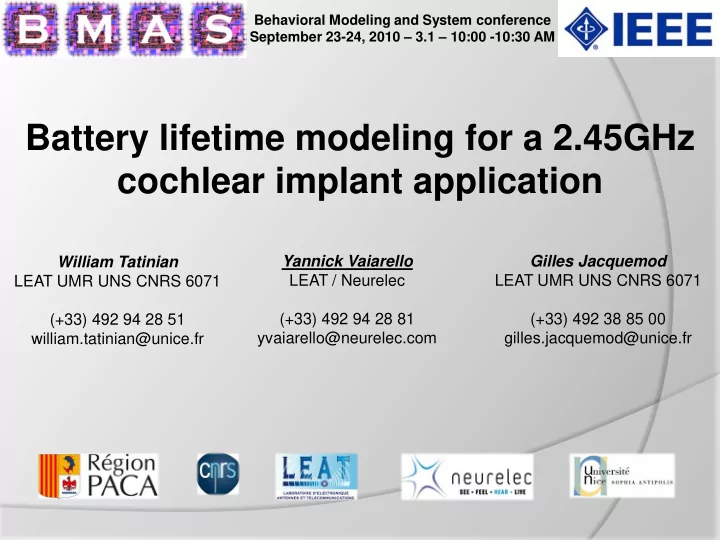

Behavioral Modeling and System conference September 23-24, 2010 – 3.1 – 10:00 -10:30 AM Battery lifetime modeling for a 2.45GHz cochlear implant application Yannick Vaiarello Gilles Jacquemod William Tatinian LEAT / Neurelec LEAT UMR UNS CNRS 6071 LEAT UMR UNS CNRS 6071 (+33) 492 94 28 81 (+33) 492 38 85 00 (+33) 492 94 28 51 yvaiarello@neurelec.com gilles.jacquemod@unice.fr william.tatinian@unice.fr
Outlines Introduction Communication for cochlear implant Modeling Heterogeneous Simulation Framework Channel and Antenna Modeling and simulation Transmitter Modeling Implementation and Simulation Results Conclusion 2 BMAS 2010 - Session 3.1 - Yannick VAIARELLO
Introduction Severe to Profound Deafness Current cochlear implant: inductive system Visible and unattractive 3 BMAS 2010 - Session 3.1 - Yannick VAIARELLO
Behavioral Modeling and System conference September 23-24, 2010 – 3.1 – 10:00 -10:30 AM Communication for cochlear implant 4 BMAS 2010 - Session 3.1 - Yannick VAIARELLO
Communication for cochlear implant Equivalent Channel 5 BMAS 2010 - Session 3.1 - Yannick VAIARELLO
Communication for cochlear implant Wire connection not allowed for biomedical application => RF system Integration of the emitter within ear canal Small Battery: low power Miniature antenna 2.45 GHz: Good tradeoff between antenna efficiency and transmission losses 6 BMAS 2010 - Session 3.1 - Yannick VAIARELLO
Behavioral Modeling and System conference September 23-24, 2010 – 3.1 – 10:00 -10:30 AM Modeling 7 BMAS 2010 - Session 3.1 - Yannick VAIARELLO
Modeling Schematic: power low noise amplifier amplifier audio signal Demod . Modulator (BB + RF) Analog architecture fixed LNA sensitivity Transmission losses depend on patient anatomy Variation of transmitted power Critical points: PA and Propagation Channel 8 BMAS 2010 - Session 3.1 - Yannick VAIARELLO
Modeling Heterogeneous Framework Analog and RF simulation: Electrical using SPICE simulator Antennas and Channel : Electromagnetic simulator : Ansoft HFSS Battery Lifetime model on Simulink 9 BMAS 2010 - Session 3.1 - Yannick VAIARELLO
Modeling Antenna and Channel Modeling Electromagnetic Simulation of the propagation channel Extraction of the equivalent circuit L r L e C e C r R loss-r R loss-e V receive =PL.V transmit R rad-r R rad-e V transmit 10 BMAS 2010 - Session 3.1 - Yannick VAIARELLO
Modeling Simulation Issues Electromagnetic simulation: Using sophisticated head phantom: 1 week on a 2.8GHz Core2Duo 4GB RAM Using equivalent medium phantom: 1 day on a 2.8GHz Core2Duo 4GB RAM Analytical model: ε + ε + ε . t . t . t ε = skin skin fat fat cart cart + + eq t t t λ D skin fat cart = − m PL ( ). exp( ) π δ 4 D eq 11 BMAS 2010 - Session 3.1 - Yannick VAIARELLO
Modeling Simulation Issues Typical attenuation in transmission channel: 25 dB LNA Sensitivity: - 55 dBm (internal design) Losses due to antennas efficencies: - 15 dB Typical Transmitted Power: -15 dBm Channel Variation => Transmitted Power and Battery Lifetime Variations 12 BMAS 2010 - Session 3.1 - Yannick VAIARELLO
Modeling Transmitter Modeling PA Tuning: V dd modulator ref out matching gnd V dd (V) 500 Power consumption 1.05 1.15 1.25 1.35 1.45 400 300 Pout(dBm) -10 200 (µW) 100 -15 0 0 50 100 150 200 250 P out (µW) -20 13 BMAS 2010 - Session 3.1 - Yannick VAIARELLO
Modeling Implementation Battery Lifetime estimation: Using Simulink ( also implementable in any simulator ) 14 BMAS 2010 - Session 3.1 - Yannick VAIARELLO
Behavioral Modeling and System conference September 23-24, 2010 – 3.1 – 10:00 -10:30 AM Results 15 BMAS 2010 - Session 3.1 - Yannick VAIARELLO
Results Battery Lifetime estimation according to channel variations : T skin (mm) T cart (mm) T fat (mm) Loss (dB) Best 0.5 2 20 19.4 Typical 1 4 34 25.5 worst 2 6 50 30.4 Lifetime Pt (µW) P PA (µW) P tot (µW) (days) Best 10 96 396 12 Typical 30 139 439 11 Worst 100 250 550 9 16 BMAS 2010 - Session 3.1 - Yannick VAIARELLO
Results Battery Lifetime estimation according to other variations : Typical => 3% efficiency ; adaptation @ -20 dB P PA Lifetime Pt (µW) P tot (µW) (µW) (days) Typical 30 139 439 11 Antenna adaptation @ - 10 dB 33 144 444 10.8 Antenna adaptation @ - 6 dB 36 148 448 10.7 Antenna Efficiency x2 15 115 415 11.5 17 BMAS 2010 - Session 3.1 - Yannick VAIARELLO
Channel noise modeling and simulation Worst Case ASK modulation: P 1 /P 0 = 0 dBm /- 10 dBm Noise Channel (WIFI interference ): 20 dBm @ 3m 18 BMAS 2010 - Session 3.1 - Yannick VAIARELLO
Conclusion Channel losses are very important on biomedical transmission This model permit to: Know the transmitted power necessary Evaluate multiple modulation to find the better SNR Optimise the bitrate with digital modulation 19 BMAS 2010 - Session 3.1 - Yannick VAIARELLO
Behavioral Modeling and System conference September 23-24, 2010 – 3.1 – 10:00 -10:30 AM Thank you for your attention. Any Questions ? 20 BMAS 2010 - Session 3.1 - Yannick VAIARELLO
Recommend
More recommend